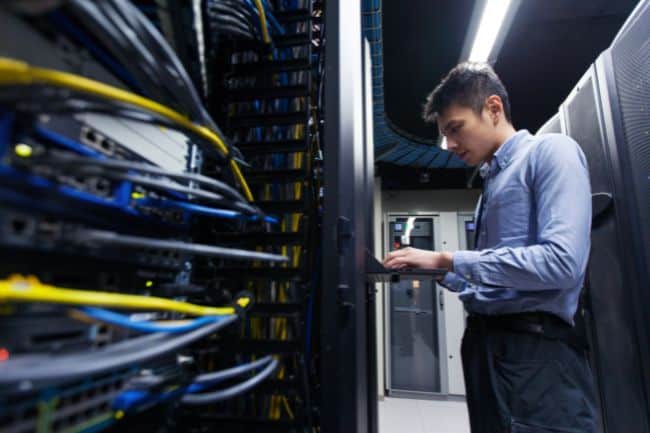Your data has to live somewhere. It used to be that data always lived onsite in servers owned and managed by the businesses themselves.
With the growing popularity of remote work and cloud deployments, many businesses are starting to rethink the way their data is stored.
Enter Data Center-as-a-Service.
What Is Data Center-as-a-Service?
Data Center-as-a-Service (DCaaS) is when a company offers use of their offsite physical data center infrastructure to clients. A client rents or leases space in the data center, gaining access to the provider’s servers, networking, computing resources, and storage.
Businesses utilizing DCaaS outsource a portion or all of their data center. Organizations alleviate logistical or budgetary constraints associated with their onsite data center through outsourcing.
DCaaS shouldn’t be confused with data center services, which involve administering an organization’s on-premises data center resources. The less popular option is renting space in an offsite data center. While the space rental is similar to DCaaS, the hardware is still purchased and maintained by the organization, just like onsite infrastructure.
Benefits of Data Center Services (or DCaaS)
DCaaS provides businesses access to data center infrastructure and services despite IT staffing or budget constraints. There are several additional advantages to DCaaS:
- Customizable. DCaaS is highly customizable to the organization. DCaaS clients can choose the level of service right for their business.
- Innovation. Since the provider maintains infrastructure, they can remain agile in the ever-changing tech landscape. Whether upgrading software to better secure resources or managing hardware, a DCaaS provider handles the innovation and management for you.
- Flexibility. Data center resources scale to meet the increased need of organizations.
- Speed. Clients experience reduced wait times for new hardware or software, as those tasks are completed without disrupting work.
- CapEx to OpEx. DCaaS offers organizations access to enterprise-level hardware and services without capital expense. In many cases, the level of hardware and services of DCaaS providers is too costly for most businesses to access otherwise. Small and midsize organizations particularly benefit from this arrangement. Something that might cost $500,000+ as an enterprise solution is now available for a monthly fee, along with the technical resources for implementation.
DCaaS enables smaller companies to get started without a huge investment, allowing companies that could never have afforded the infrastructure the advantages of the data center.
Data Center Trends
There is a myriad of trends associated with data centers as a whole, but the following are what we foresee about DCaaS.
- Artificial intelligence and machine learning are on track to be significant parts of DCaaS. As these services continue to improve, it’s not a stretch to see them continually optimizing data center services. Continued automation promises faster response times to issues and threats as less human interaction is necessary.
- Hybrid cloud solutions will continue to grow in popularity as organizations leverage cloud solutions to suit their organization.
- Edge computing will continue to influence data storage. The popularity of personal hotspots and publicly accessible internet can affect the user side. DCaaS offers redundancies to mitigate this in the form of multiple service providers, power generators, cooling, cabling, etc.
DCaaS Challenges
There are always challenges associated with technology, and DCaaS is not immune.
Internet access is the main challenge of DCaaS. Since access is remote, so internet connection is required. While this is convenient when working offsite, internet connection loss creates downtime.
How Anteris Can Help
We’re staying in front of the data storage trends. We’ve seen what is coming and built out our data center to meet the future needs of our Clients.
Our HaaS structure allows for greater availability of equipment. Since we maintain an inventory of related models, we can quickly and efficiently dispatch replacements when required. Hardware-as-a-Service provides a longer use-life and more excellent value for the team.
In addition, we can combine hardware to create greater resilience. We can do this in various ways, such as linking onsite servers to our data center or installing multiple servers on the same site so that if one fails, others are online. These solutions could easily cost up to $100,000, putting a significant strain on your bottom line. At Anteris, we’ve already made these investments—and more–allowing our Clients to access enterprise-level technology at a fraction of the cost.
That’s the benefit of Haas: turning what would usually be a considerable capital expense into an operating expense.
If you’re ready to talk about upgrading your IT setup or have more questions, we’re here.
Let us make your technology freeing, not frustrating.








